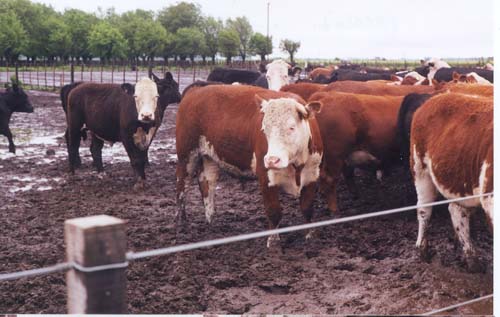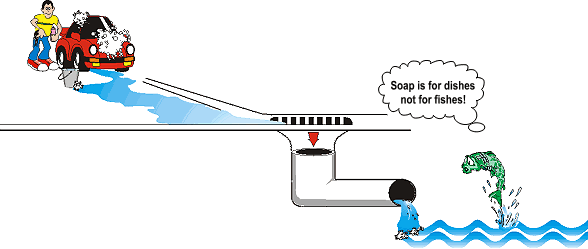
Sources of Coastal Pollution
Pollution sources are classified as point sources or non-point sources by the US Environmental Protection Agency. Information about pollution sources is included in their pages on Point Source and Non-Point Sources of pollution.
Point Sources
Point sources are:
Any discernible, confined, and discrete conveyance, including but not limited to, any pipe, ditch, channel, tunnel, conduit, well, discrete fissure, container, rolling stock concentrated animal feeding operation (CAFO), landfill leachate collection system, vessel or other floating craft from which pollutants are or may be discharged. This term does not include return flows from irrigated agriculture or agricultural storm water runoff.
From EPA Glossary.Point sources generally enter receiving water bodies at some identifiable site(s) and carry pollutants whose generation is controlled by some internal process or activity, rather than weather.
From US Environmental Protection Agency National Management Measures to Control Nonpoint Source Pollution from Agriculture.
Point sources include combined sewer overflows, concentrated animal feeding operations, sanitary sewer overflows, storm water, oil spills, industrial discharges; discharge from boats, and dumping of ballast water from ships.
Wisconsin Feedlot. The soil is wet from rain, urine, and manure. and it is a rich source of bacterial, viral, and nutrient pollution.
From Clean Water Action Council of Northeastern Wisconsin, Inc.
Non-Point Sources
Nonpoint source pollution generally results from land runoff, precipitation, atmospheric deposition, drainage, seepage, or hydrologic modification. Technically, the term "nonpoint source" is defined to mean any source of water pollution that does not meet the legal definition of "point source" in section 502(14) of the Clean Water Act.
From EPA Polluted Runoff Background Paper.
Non-point sources include:
- Runoff from farm lands and managed forestsin the coastal zone that carry fertilizer, excess nutrients, pesticides and herbicides, salts in irrigation water, and crop residues.
- Runoff from agricultural areas (excluding concentrated animal feeding operations) that carries nutrients, animal wastes, manure, and pathogens (bacteria and viruses).
- Runoff
from coastal cities that carry trash, litter, heavy metals,
carbon-based chemicals such as oil from
highways, fertilizer and pet waste from backyards and sidewalks,
and detergent
(the most common pollutant).
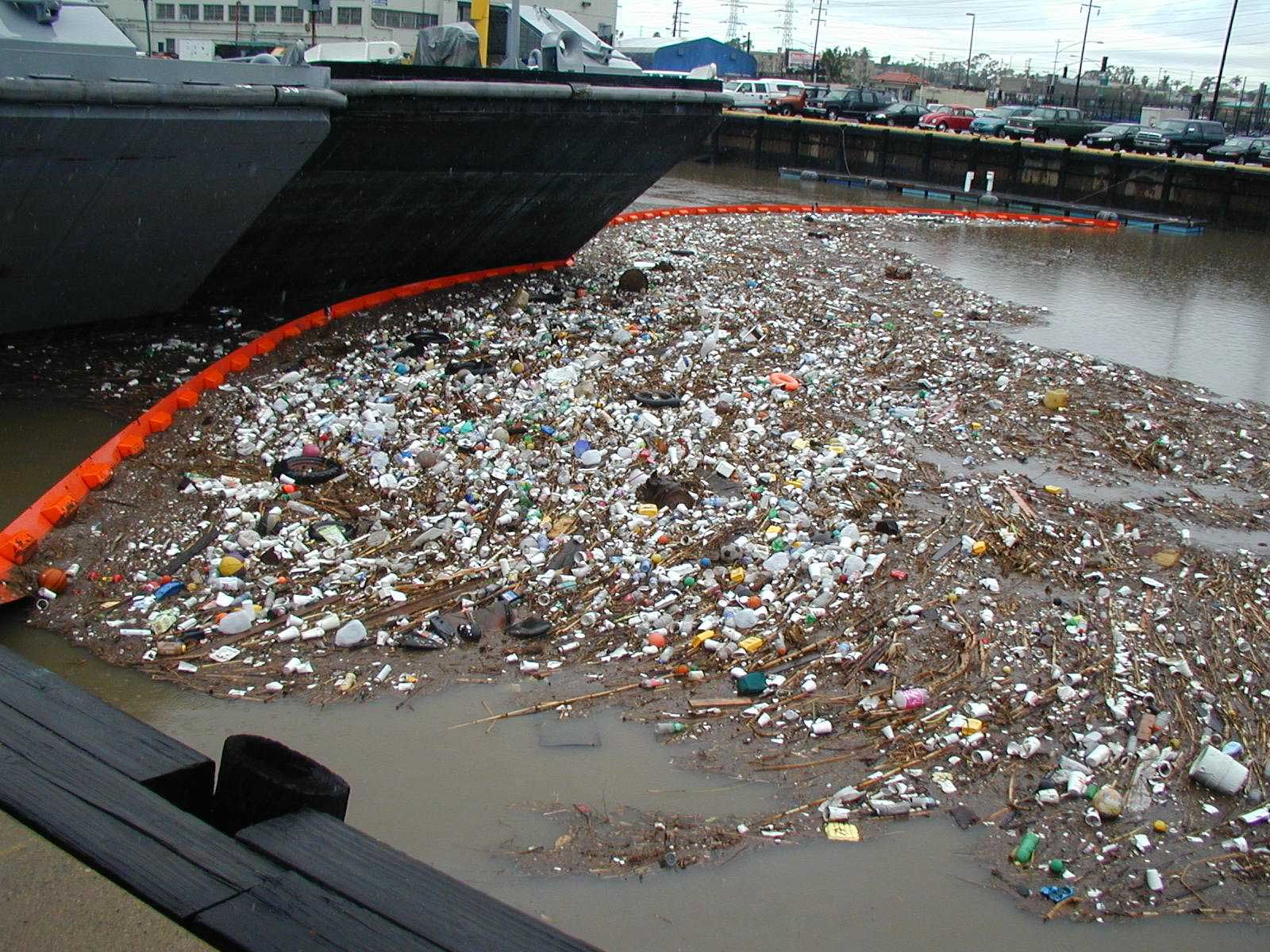
Trash from land carried into the ocean by rains. Click on image for a zoom.
From Daniel Taylor, Synthesis Magazine.
- Acid mine drainage.
- Hydromodification.
Hydromodification is one of the leading sources of impairment in streams,
lakes, estuaries, aquifers, and other water bodies in the United States.
Three major types of hydromodification activities change a waterbody's
physical structure as well as its natural function. These changes can
cause problems such as changes in flow, increased sedimentation, higher
water temperature, lower dissolved oxygen, degradation of aquatic habitat
structure, loss of fish and other aquatic populations, and decreased
water quality.
The changes are:
- Channelization and channel modification, including cutting new channels through barier islands, or closing such channels.
- Dams.
- Stream bank and shoreline erosion.
- Marinas and boating facilities.
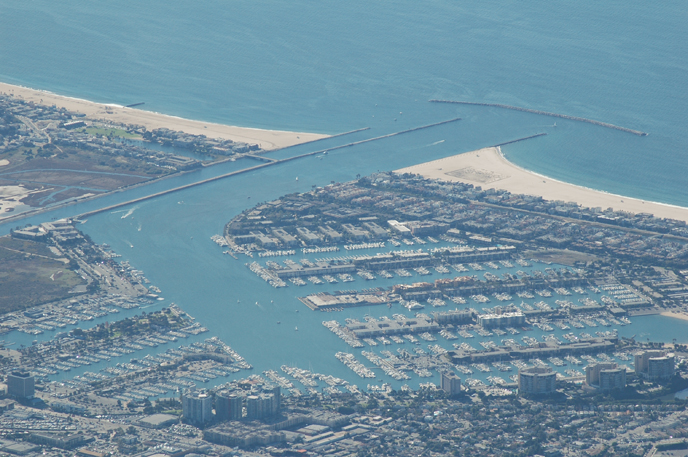
Marina Del Rey, California, a coastal lagoon turned into urban development and marinas.The area was originally known as Ballona Lagoon. Click on image for a zoom.
From Bruce Perry, California State University Long Beach.
Rancho La Ballona was characterized by two great creeks; Ballona Creek running from the east to west and creating a great lagoon and Centinela Creek running from the northern hills to Ballona Creek ... As the 19th century came to a close, La Ballona was considered a “swamp” and the only activity occurred at the mouth of Ballona Creek where the squatter Will Tell opened a sea shore retreat that would “furnish sportsmen with board and lodging for man and beast.”
From Del Rey Neighborhood Council.
- Atmospheric deposition of sediments and chemicals carried by the
wind.
- Mercury in water comes mostly from the atmosphere.
- 55% of mercury emissions are natural, from volcanoes and forest fires.
- 42% are man made outside the USA.
- 1% come from US power plant emissions.
- Under some conditions, excess sand, silt, and clays (sediments) eroded from land, especially land denuded of plants that hold sediments. Mostly, sediments are needed by the coastal zone. Excess sediments that bury plants, or sediments in water that is historically sediment free, such as water near coral reefs, are pollutants.
- Groundwater discharge which can include all types of pollutants, including water from faulty septic systems.
- Solvents used to clean boats, anti-fowling agents leached from hulls. Anti-fowling agents are designed to be highly toxic to marine life that settles on to hard surfaces.
- Trash dumped from ships, dropped on beaches, and washed into the ocean.
Beach Pollution
The most common sources of bacterial pollution at beaches and near-shore waters are:
- Unknown, very few governmental agencies track the source of pollution on their beaches.
- Runoff from land, including urban areas and intensive farming operations. Runoff from urban lawns and streets contains waste from millions of pets. Pollution is greatest from areas with the largest percentage of impervious surfaces (roofs, paved streets and parking lots). A study conducted in South Carolina found that a watershed that was 22 percent covered by impervious surfaces had an average fecal coliform count seven times higher than a watershed that was 7 percent covered by impervious surfaces (Mallin, 2006).
- Sewage spills and overflows, including spills caused by heavy rains overloading combined sewage systems (combination of street drains and sanitary sewage).
- Boat spills and wildlife, although these are not very important.
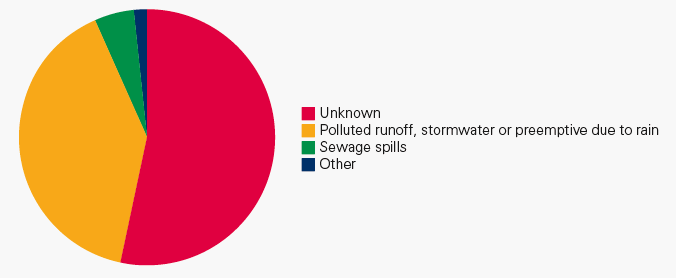
Sources of bacterial pollution causing 25,643 days of beach closings at US vacation beaches in 2006.
From Testing the Waters: A Guide to Water Quality at Vacation Beaches by the Natural Resources Defense Council
(Dorfman, 2004).
Summary
Read this United States Geological Survey fact Sheet on Nitrogen in the Mississippi Basin-Estimating Sources and Predicting Flux to the Gulf of Mexico.
What Can I Do?
The Coastal Waccamaw Storm water Education Consortium has useful information.
Good water quality depends on us, and we depend on good water quality. And ensuring good water quality starts with individuals like you! There are many things that you can do around your home and in your everyday life to help manage storm water and control nonpoint source pollution in order to protect water quality. Consider the impact on our local waters if everyone took these simple steps.
- Remember, storm drains lead to the rivers, which lead to the sea. Never put anything into a storm drain.
- Pet owners should pick up after their pets and dispose of pet waste in the garbage.
- Don't litter.
- Plant rain gardens, vegetated buffers, and maintain vegetation.
- Properly maintain your septic system.
- Maintain your car to prevent oil and fluid leaks.
- Wash your car at a car wash or over the grass to prevent the soap and wash water from flowing into nearby storm drains.
- Use fertilizers and pesticides sparingly and only as directed. Consider organic, non-toxic alternatives to these chemicals.
- Do not allow yard waste such as leaves and grass clippings to blow into gutters or onto paved surfaces to be washed into storm drains.
- Report erosion and sediment problems from construction sites.
- Minimize impervious surfaces.
- Get involved in local river and beach clean ups, and other projects that help protect water quality.
Humbolt County California points out that for their citizens, Humbolt Bay Starts on Your Street.
Fort Worth maintains a web site listing sources of urban pollution, and how the city is reducing the pollution.
From Fort Worth Detergent is our Number One Pollutant
References
Dorfman, M. and N. Stoner (2007). Testing the Water: A Guide to Water Quality at Vacation Beaches, Natural Resources Defense Council: 375.
Mallin, M. A. (2006). Wading in Waste. Scientific American: 53--59.
Revised on: 29 May, 2017

